Mugolio, a dark, aromatic syrup imbued with the flavor of pine cones, is the poster child for the kind of crazy cool, Illuminati-esque foodstuff foragers have access to, all for the price of a hike, or even less, depending on how close you are to some pine trees.
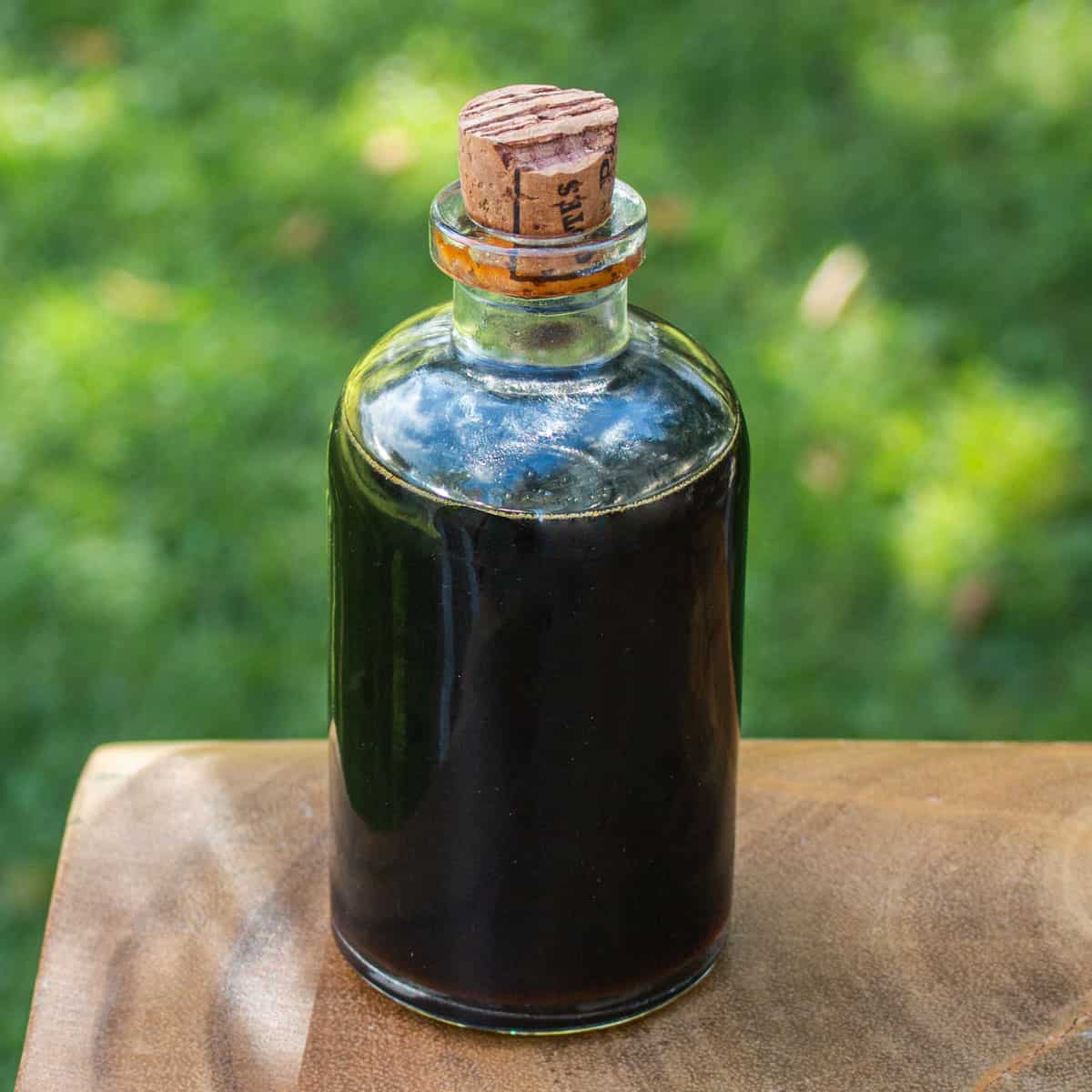
The syrup came on my radar when my friend Dan Farmer gave me a little jar of some he made to try. I remember it being good, but I forgot about it until I opened the Salt Cellar, and started making my own from spruce tips, which is excellent, but not quite the same as pine cone syrup (for the record both are great).
Mugolio is now still a bit of a chef secret, and available through elite specialty distributors, but the price is staggeringly high, exorbitant even, when you consider you can make nearly the exact same thing at home, for less than it costs to make a cake.

A chef secret that takes months to make
The cost of mugolio is not found in ingredients, but is paid in time. How much time is certainly up for debate, and you’ll notice my recipe turns around a lot quicker than burying a jar of pine cones and sugar in the yard and digging it up the next year (an actual recipe from Romania). You’ll want to wait at least a month for a good pine syrup, although aging it longer can be fun.
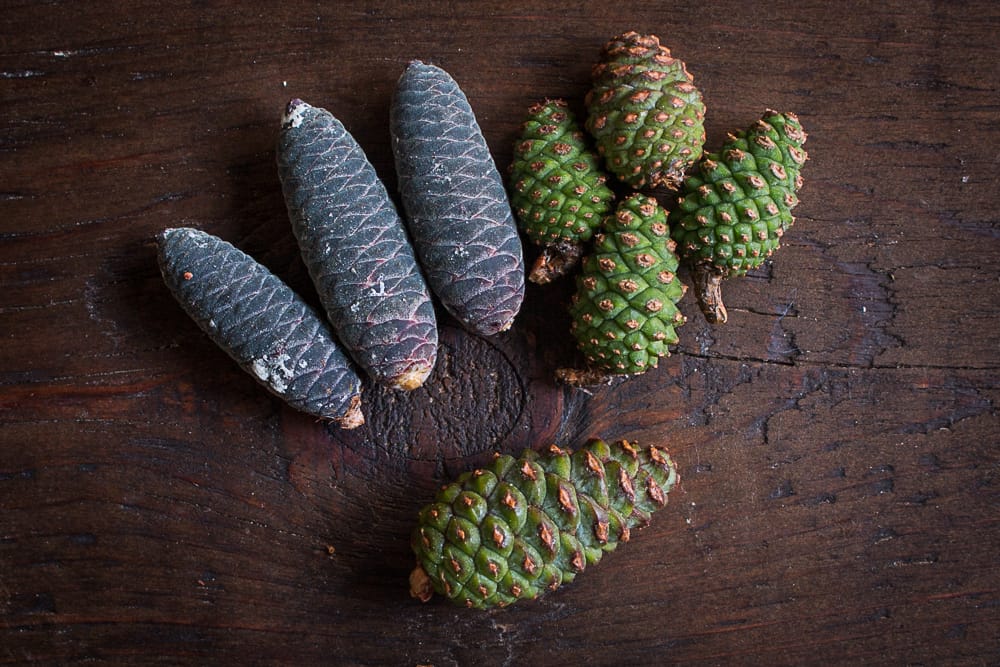
Mugolio: more than just pine cones
Real quick, some reality. I use the word mugolio interchangeably for syrups made from numerous tree parts, if you look around you’ll see mugolio usually refers to a syrup made from the young cones of mugo pine (Pinus mugo), harvested at a specific time of year, under the strictest of conditions, blah, blah, blah.
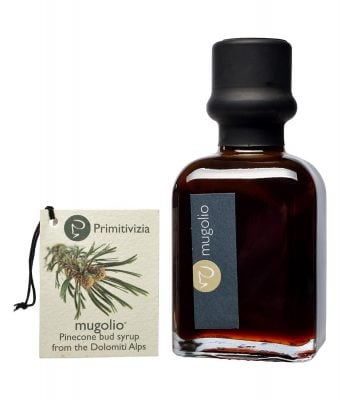
I’ve made all kinds of similar sugar based products from all kinds of conifer parts, and it isn’t some difficult, arcane thing you can only do in the light of a full moon— just the opposite.
Making mugolio is easy, and there’s a very forgiving time window for harvesting cones, or other things products like cedar cones, wintergreen, juniper, or spruce tips. All of the aforementioned making excellent syrups in their own right.
There’s something special about the pine cone syrup though. Pine cones hold more water than any other thing I’ve used, and they also ferment during the maceration process, vigorously.
The day after you combine the pine cones and sugar, there will look as if there was a rush and release of water—what was once a solid packed jar of pine cones and sugar is not 75 % full and liquid.
Species of unripe pine cones I've used to make syrup
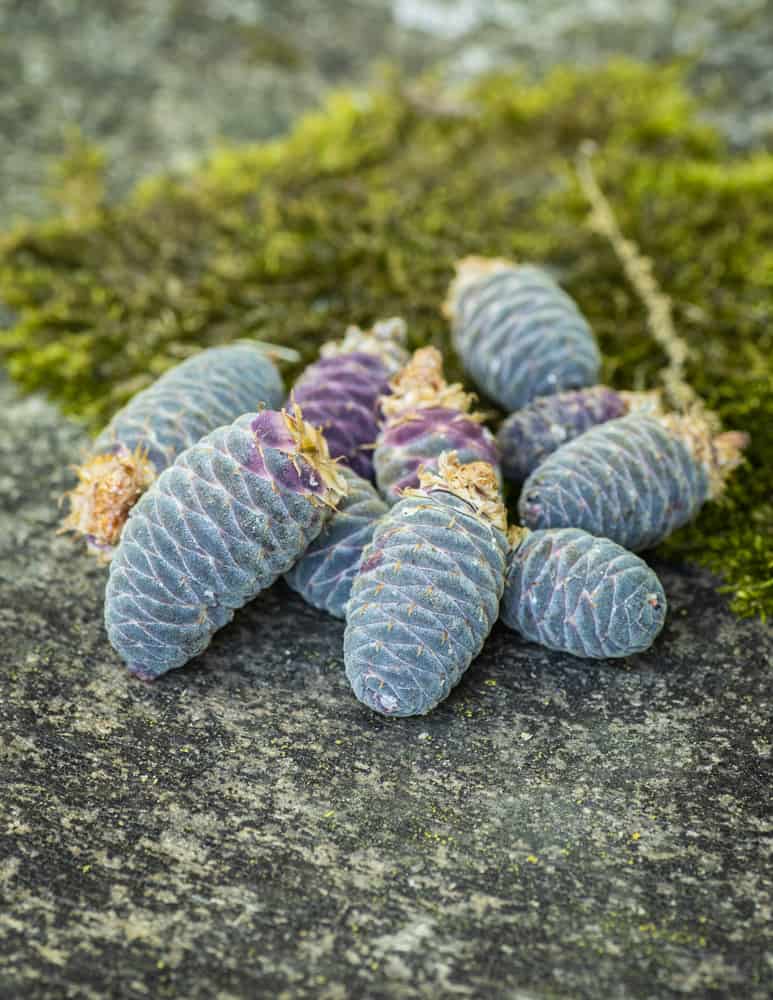
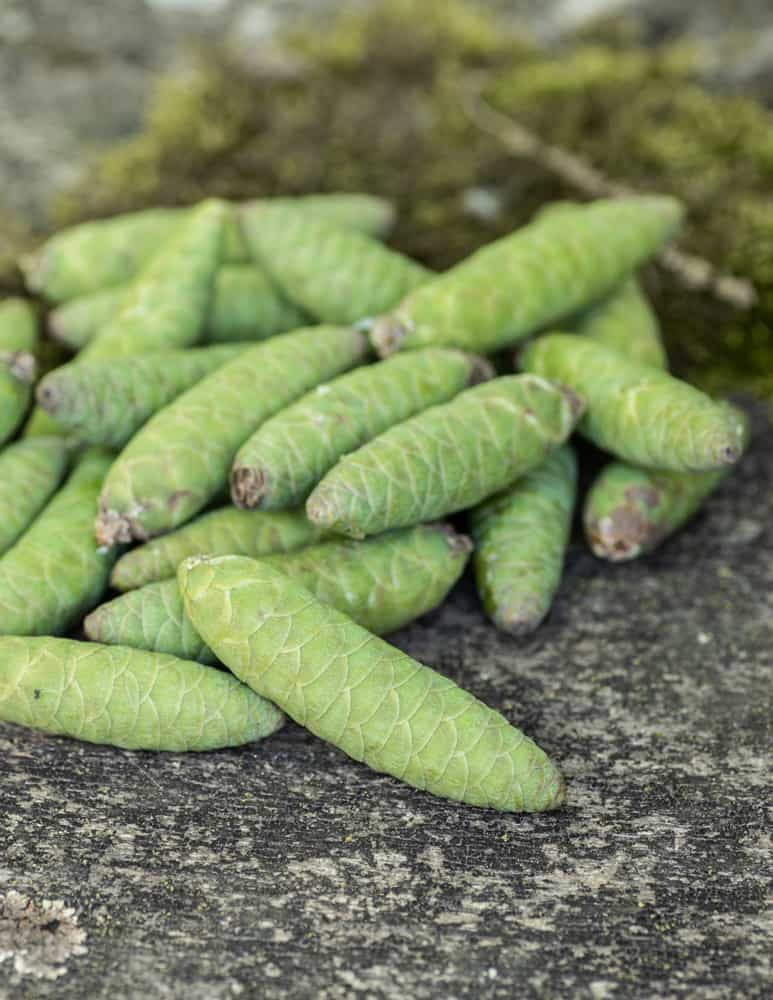
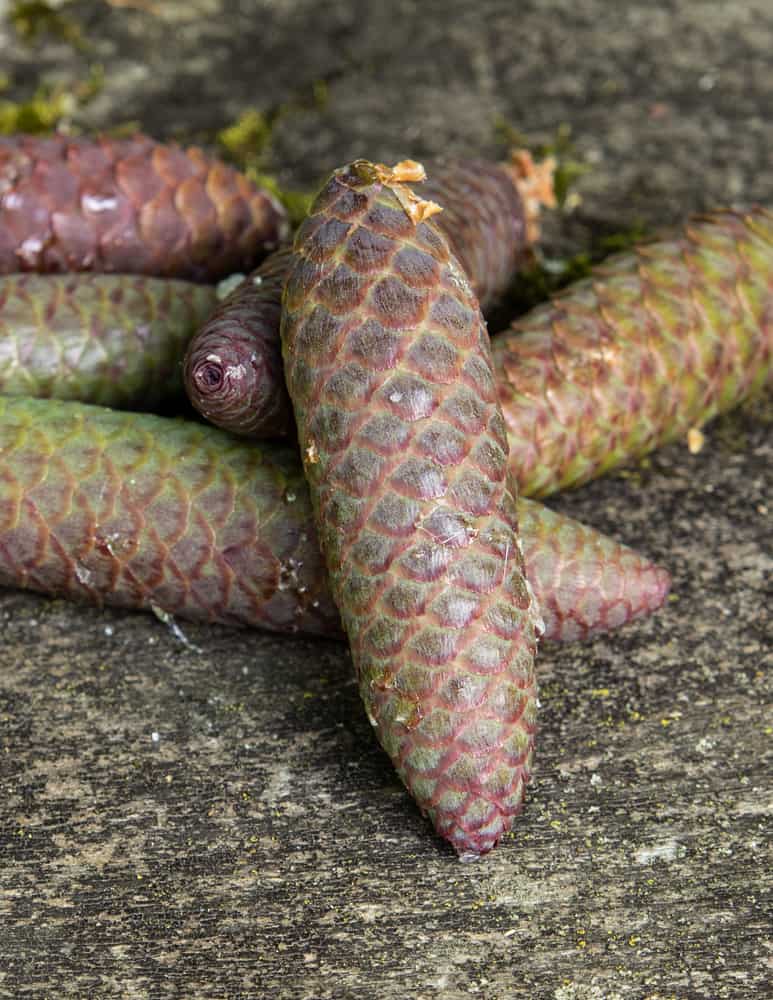
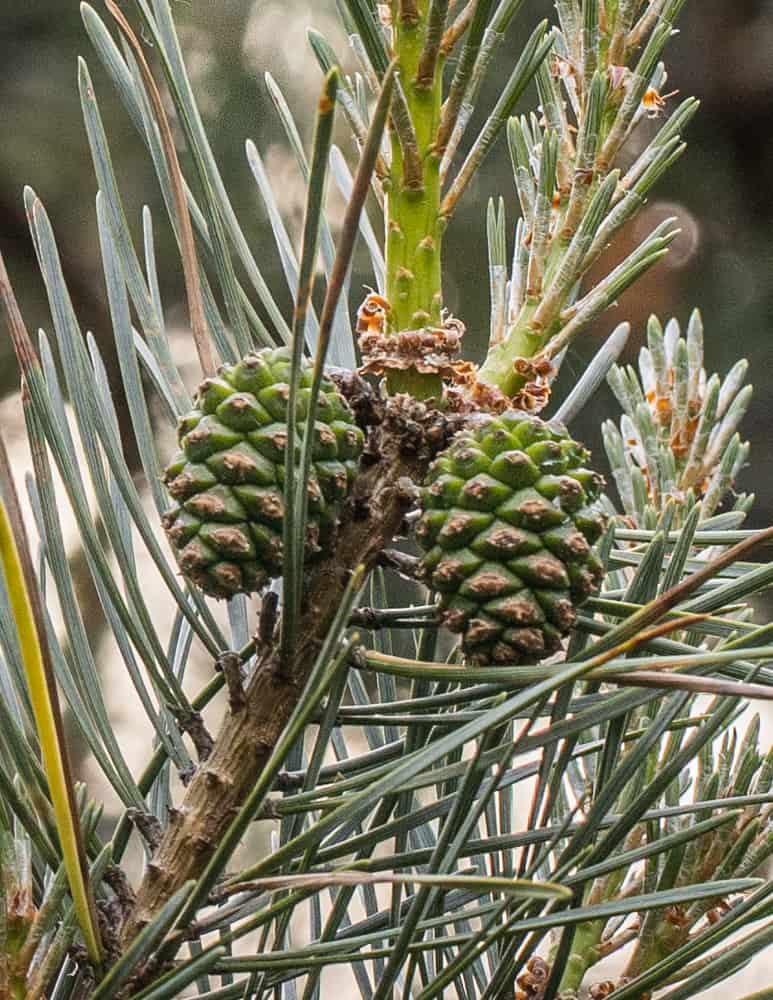
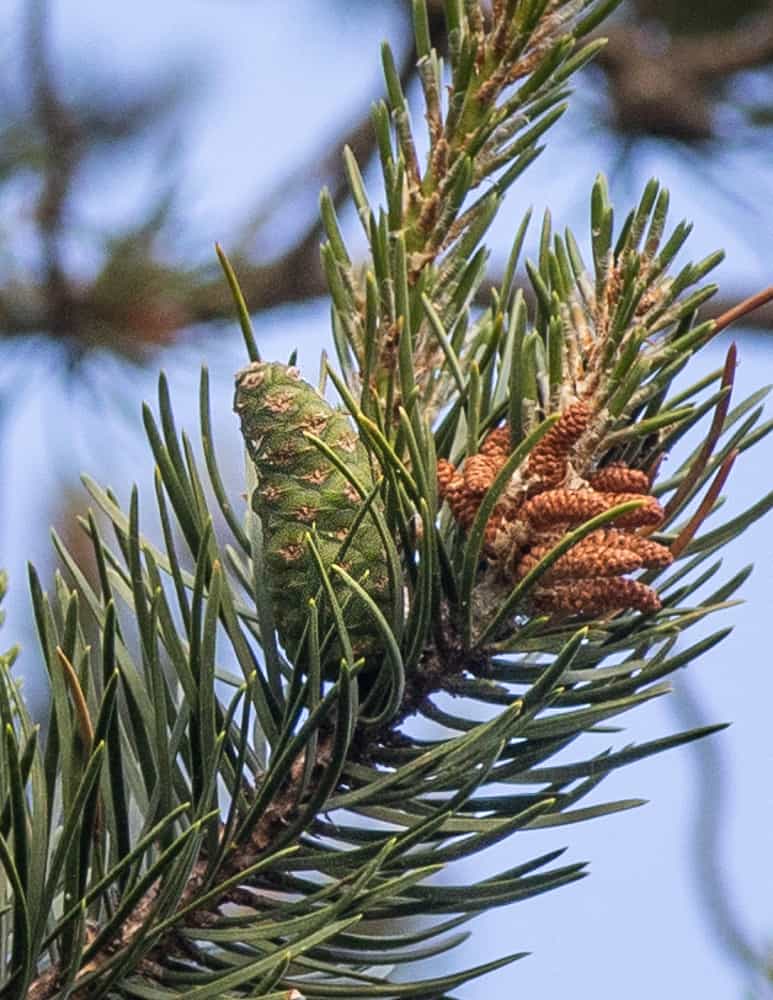
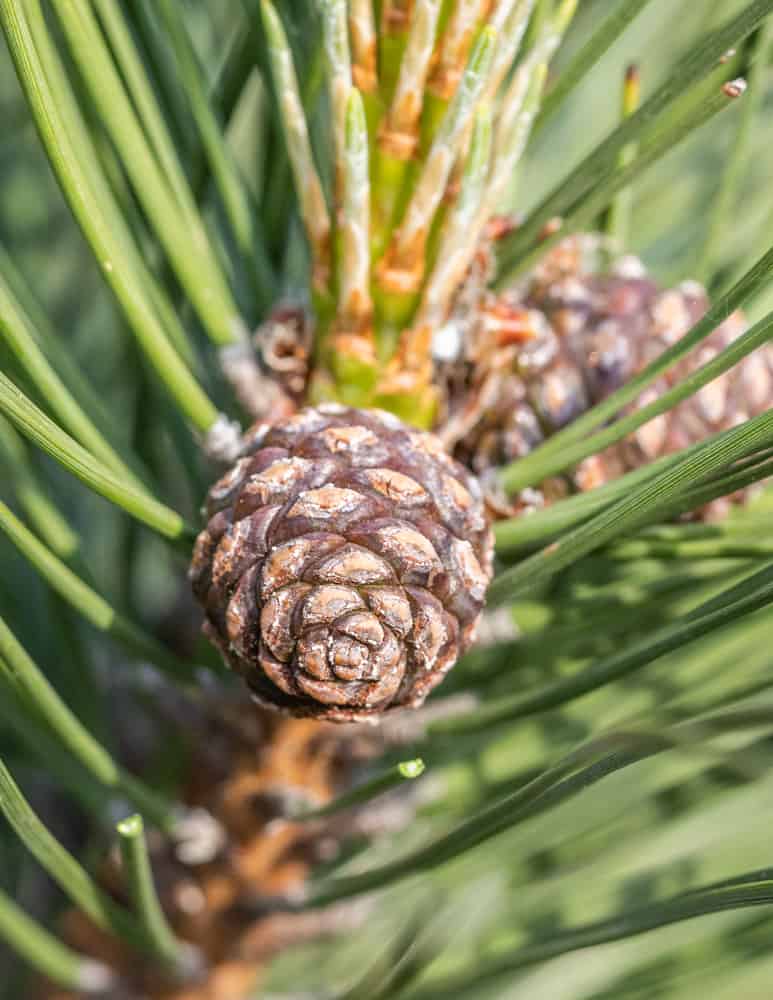
Variation in flavor between species
One of the most fascinating things about mugolio is that every species of tree you harvest unripe cones from will impart a noticeably different flavor unique to the finished product.
Once I started to notice the different flavors, I made a point out of trying to "mugolio" as many different species of unripe coniferous cone I can, and I found some fascinating things. Here's a quick breakdown of the differences between flavors I taste.

Pinus/Pines
Mugolio made from pinus cones have a resinous, assertive taste.
Picea/Spruces
Spruces lack the aggressive resinous flavor of pines and are the most subtle of all I've tasted. Instead of the resinous taste, spruce cones, just like spruce tips, have a citrusy note to them, and so will syrups made from their cones.
Thuja and likely others/Cedars
The only cedar I've made mugolio with is the green cones Thuja occidentalis, since they're easy to find in landscaping. It has a taste exactly like the aroma of fresh green cedar, a bit in between spruce and pine mugolios.
Abies/Firs
Of all the syrups here, and all the different flavors, the syrups I've made from balsam fir are the most delicious.
Firs have a resinous punch like pine mugolios, but it's slightly less aggressive, and most noticeably, comes with strong notes of warm spices like cloves, allspice, and cinnamon.
Unfortunately, mature balsam fir trees, at least around me, seem to only want to grow cones at the very top of the tree, which can make getting enough for a batch of syrup tricky.
Using other conifer products
Other tree products like spruce tips, pine tips and cedar cones I've worked with are more dry, and may not ferment during the maceration process, but they can still make a fine syrup.
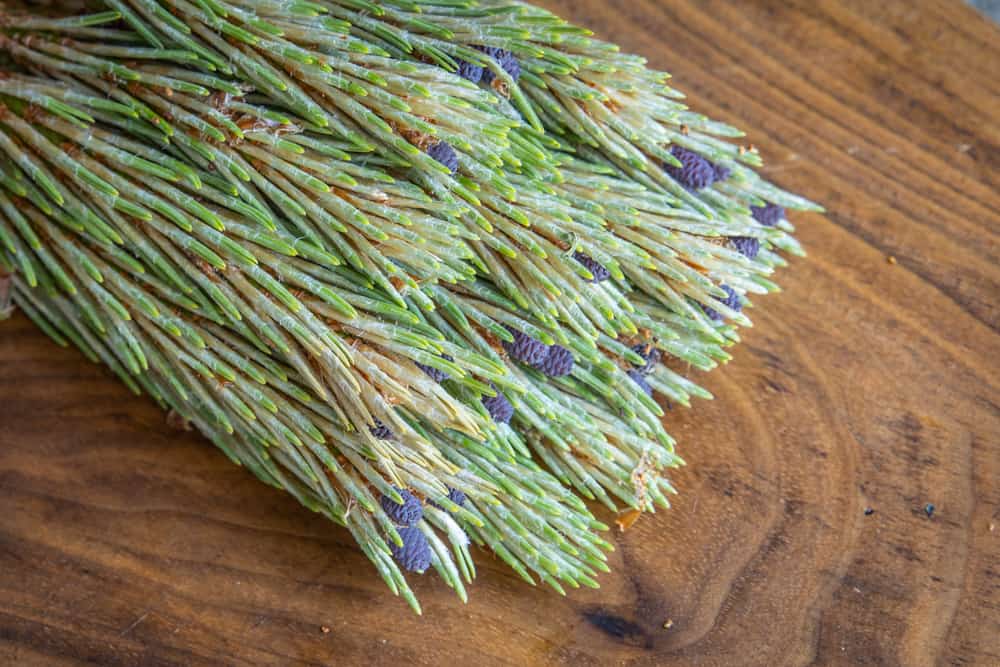
The point is: you can make syrups like this out of all kinds of things, and everyone I’ve had has been good. If you have spruce trees near you, take a look at the basic spruce tip syrup too, which is nearly the same, sans the fermentation. Here's a few things I've used:
- Unripe eastern white cedar cones (Thuja occidentalis. This could can be an abortifacient in high doses)
- Juniper berries (Juniperis virginiana)
- Spruce tips (many species)

The best part is figuring out how to use it. Somethings take some experimentation, mugolio not so much.
You can literally put it on just about anything where maple syrup would be good, and you’ll be glad you did. The syrup has the essence of pine, but with none of the strong tannins you’d expect If you took a bite out of a pine cone—just pure piney goodness.
Harvest young pine cones in spring or early summer
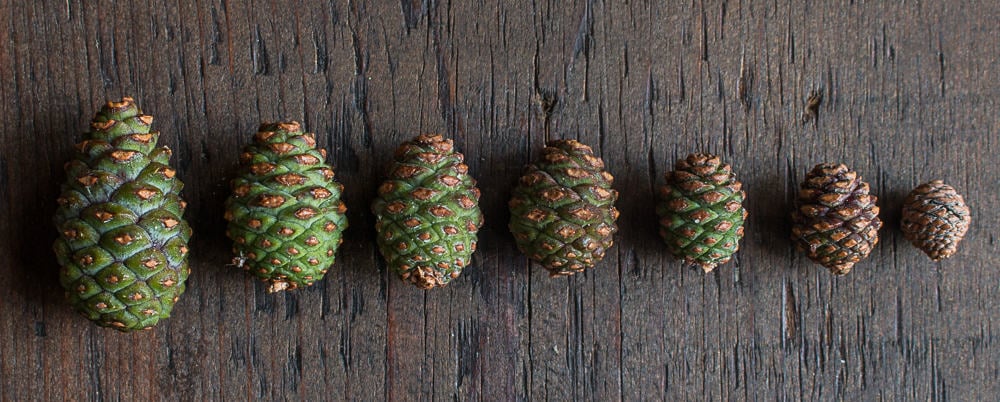
Most importantly, you are looking for unripe pine cones in the spring and early summer, not the fall, not the winter. Opened cones are not to be used.
This is up for debate, but my favorite comes from green cones as they contain more water. Purists might say that you need to harvest pine cones when they're the size of a pinky nail, or some other arbitrary size.
I can tell you after making this for years now, that any of the pine cones pictured in the image above will make a fine syrup, but smaller cones will make a syrup with a much stronger flavor, strong enough that some people may not like it.
Another good rule of thumb I've found is that whatever cone you're picking will probably be sticky and exuding resinous, sticky liquid at a prime stage for making pine cone syrup.
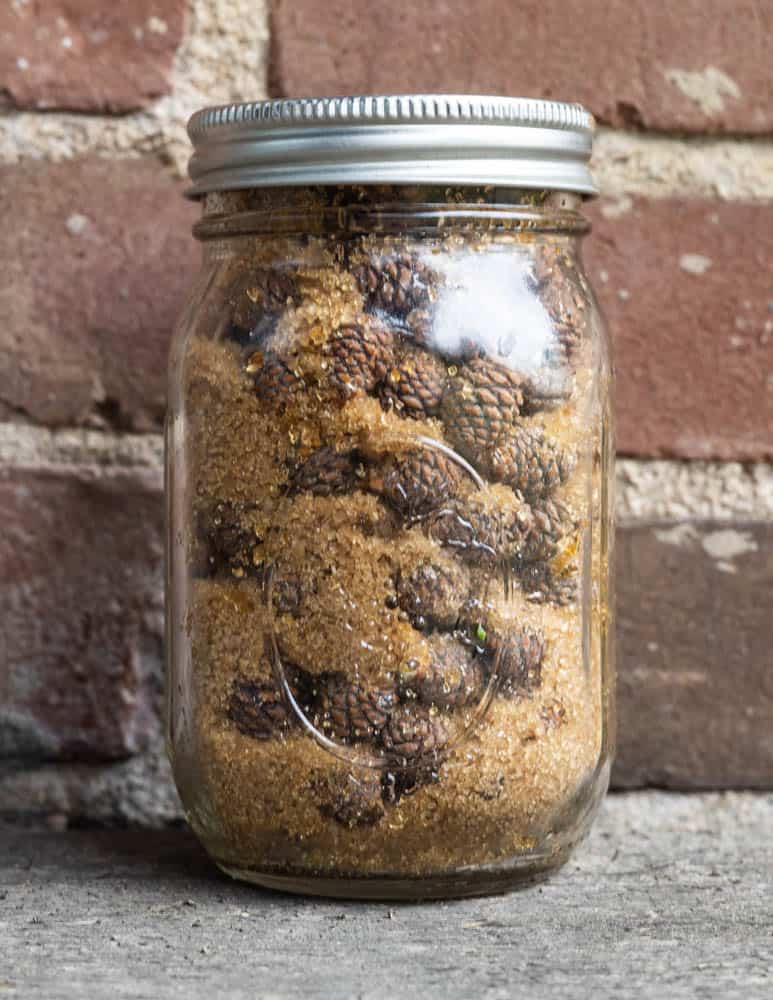
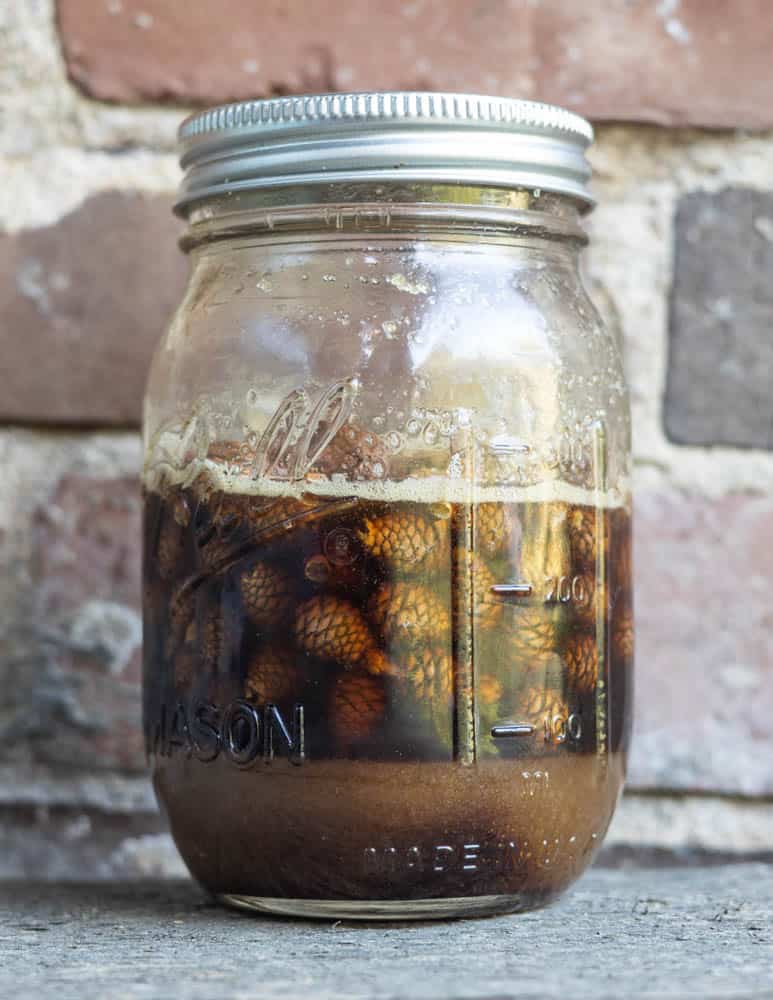
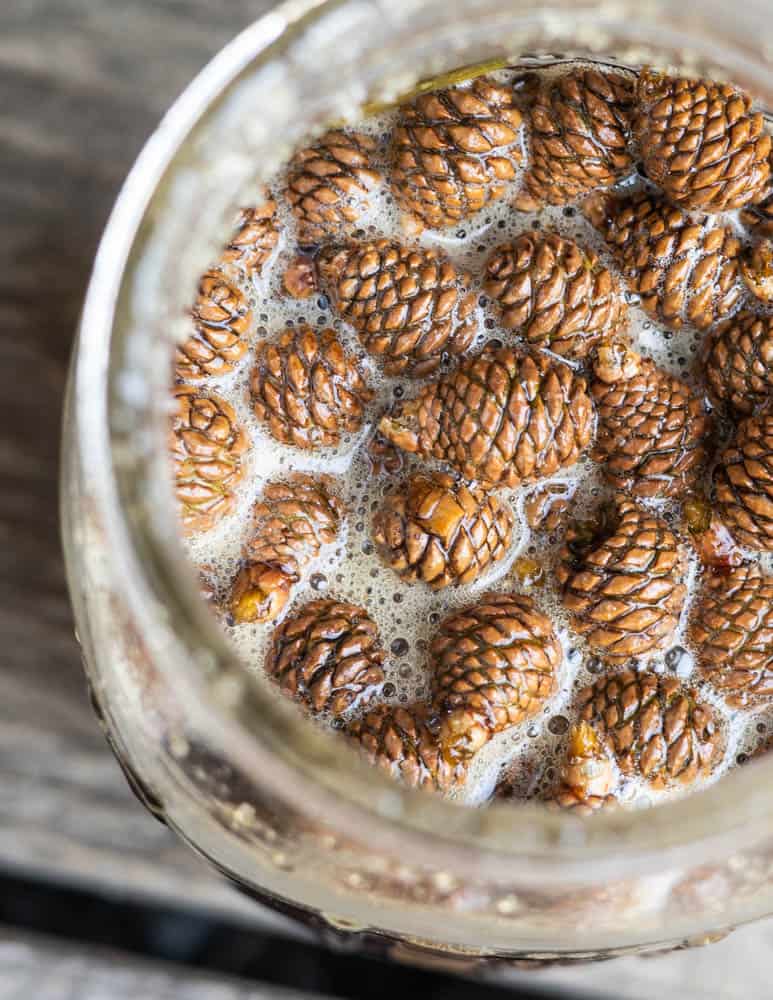
Green cone=higher water content
Larger green cones hold more water in them which makes syrup making much easier, and also allows for some fermentation in the process, which adds fun flavors.
As long as the cones are meristematic and tender, and can be cut through with a knife, even if it's into pieces with long cones like white spruce or balsam fir, they will make a good mugolio. The only cones that won't work, are mature, tough, barky cones, like those you'd see on the ground.
Using very young pine cones
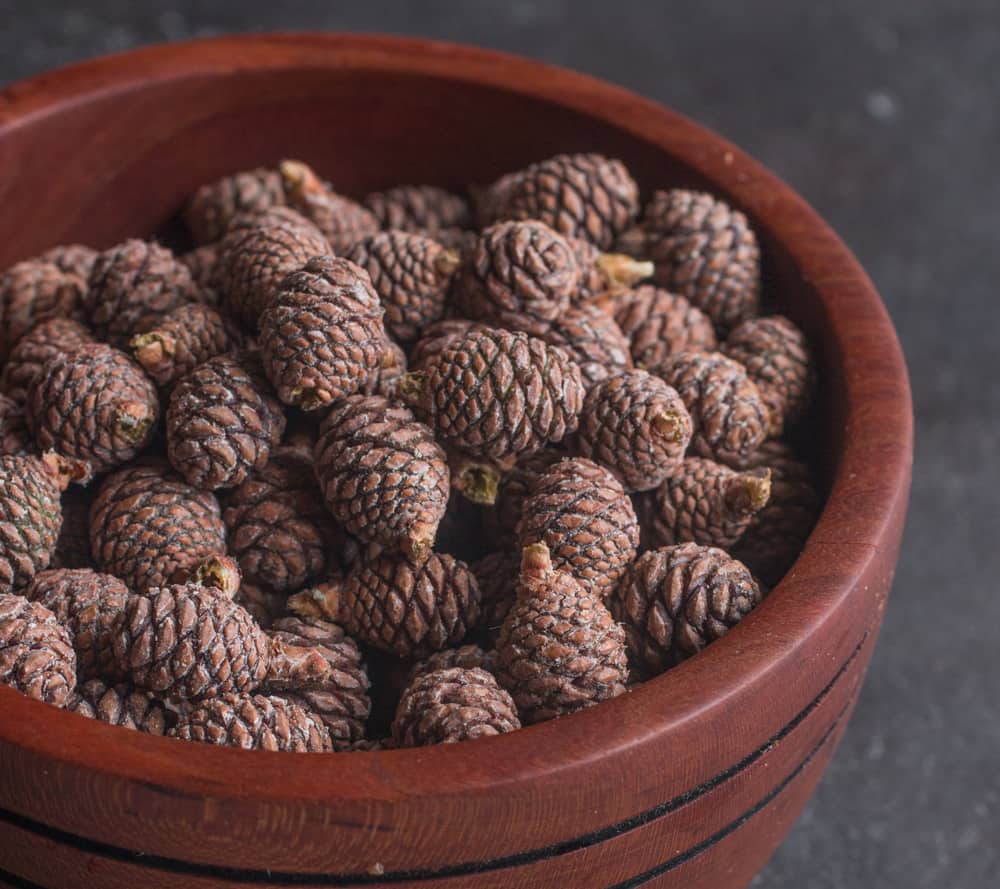
You can use young pine cones, but they're smaller and don't hold as much water as cones that are green, so they're not ideal here.
If you really want to try with very young pine cones, try chopping them up medium to make it so more cones can be fit in a jar, which means more water, meaning an easier syrup. You can also add a splash of water to help it on it's way.
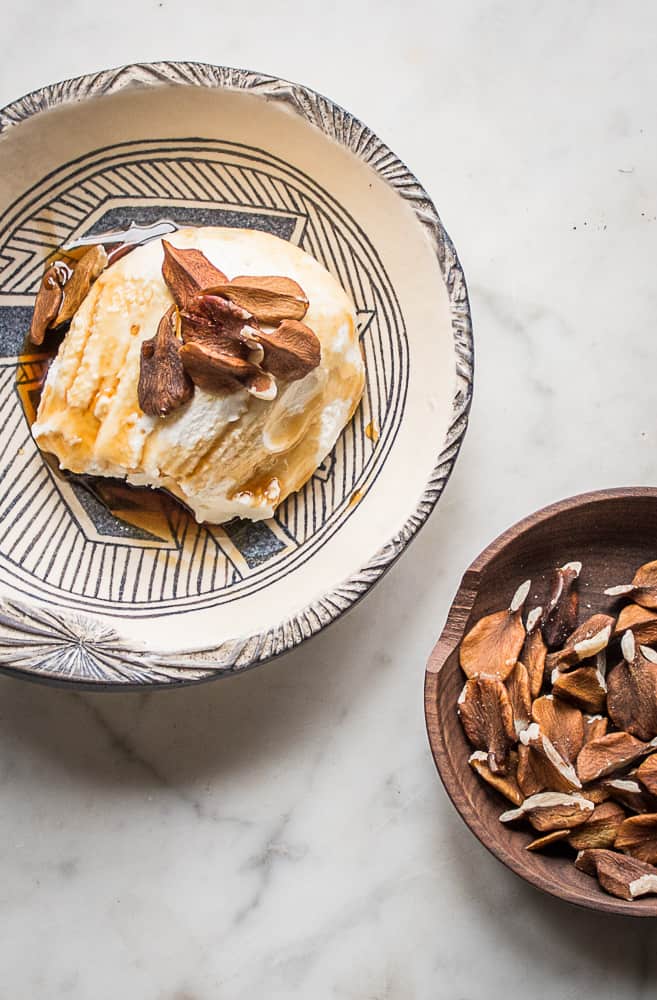
Is it safe?
Yes, this is absolutely, positively safe, and there's no need to worry about botulism. I can't speak to the exact science of spruce tip and cedar cones syrups, (also safe) but pine cone syrup is especially safe as it ferments as it macerates, due to the higher water content of the cones if harvested at the green stage.
The extended fermentation lowers the pH, making it shelf stable. Remember that sugar is a preservative, and conifer products are all naturally acidic, which is a preservative in itself.
Consider using gloves
The most prime pine and spruce cones for making syrup will be plump, but still unripe. At this stage, most of them will be very sticky and oozing a sappy resinous substance that will quickly coat your hands and will stay for hours. Consider wearing gloves to avoid sticky hand syndrome.
Choosing the right sugar
Some recipes might call for white sugar, and while it will work and give you a flavored syrup, white sugar is more dry, and I find the clear color far less attractive than the caramel color that organic, unrefined turbinado-style sugar or even light brown sugar or a similar substitute will give.
I try to avoid using plain white sugar when I can, and I highly doubt that original mugolio recipes used such highly refined products when the first adventurous people crafted them.
Use a good sugar that you can feel good about eating, and drizzling over everything, because you'll want to drizzle it, on, well, everything. Here's a list of sugars that will work
Turbinado
Turbinado is slightly more dry than commercial brown sugars, but it has an excellent flavor.
Light, golden, or dark brown sugar
These are some of the most versatile and affordable, but I suggest using a high quality organic brand. The varying molasses content of the different colors of sugar is negligible in regards to the flavor of the finished syrup.
Maple sugar
Maple sugar is the most expensive you could use, and in my opinion is not the most ideal as it's prone to crystallization from my experience. It is delicious though. If you'd like to harness the flavor of maple with your pine cones, you can just toss pine cones into maple syrup at a ratio of 1 cup of pine cones to 1 lb (2 cups) of maple syrup.
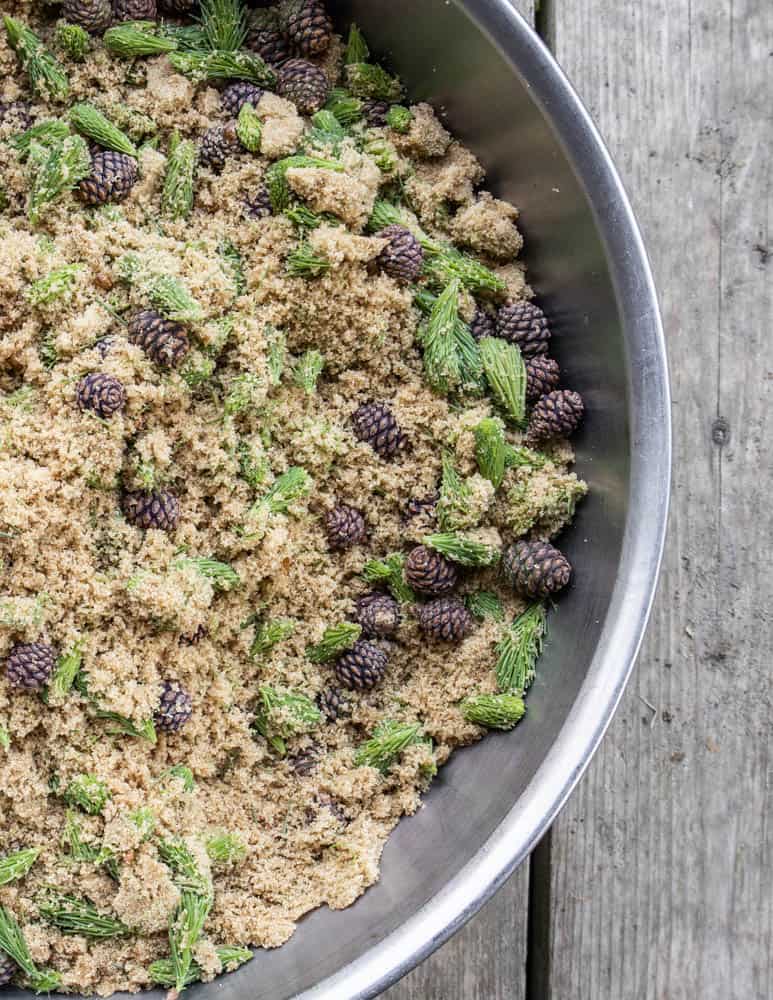
Zirbenshnaps
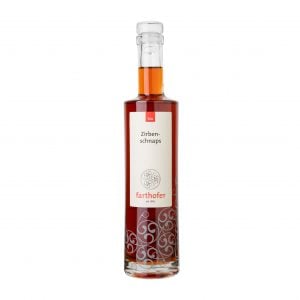
This stuff is unique enough that it needs a special mention. Zirbenschnaps is a liquor made with pine cones.
I’m not an expert on distillation by any means, but I’ve been working with a distillery to make similar products, and one thing we’ve been toying around with is making a rendition of it by simply using it as the sweetener in a macerated liquor.
The traditional zirbenshnaps has a red tone to its color, which makes me think they’re using a syrup made from fresh pine cones cooked immediately—not aged.
I know there’s also birch schnaps, and that’s made with reduced birch syrup, so I think using mugolio would be fine. Currently I know zirbenshnaps is only sold at ultra high-end restaurants in my area.
Whatever you make with it, it’s one of the most fascinating and delicious condiments made from wild ingredients I know of.
Making Large Batches
I occasionally make very large batches of syrup, 2 or 3 gallons at a time. Here's a few tips on doing that if it's something you're interested in, especially as this is such a fun (also cheap) and interesting thing to give as gifts. The tips below are intended for those people making 1 gallon batches and up at a time.
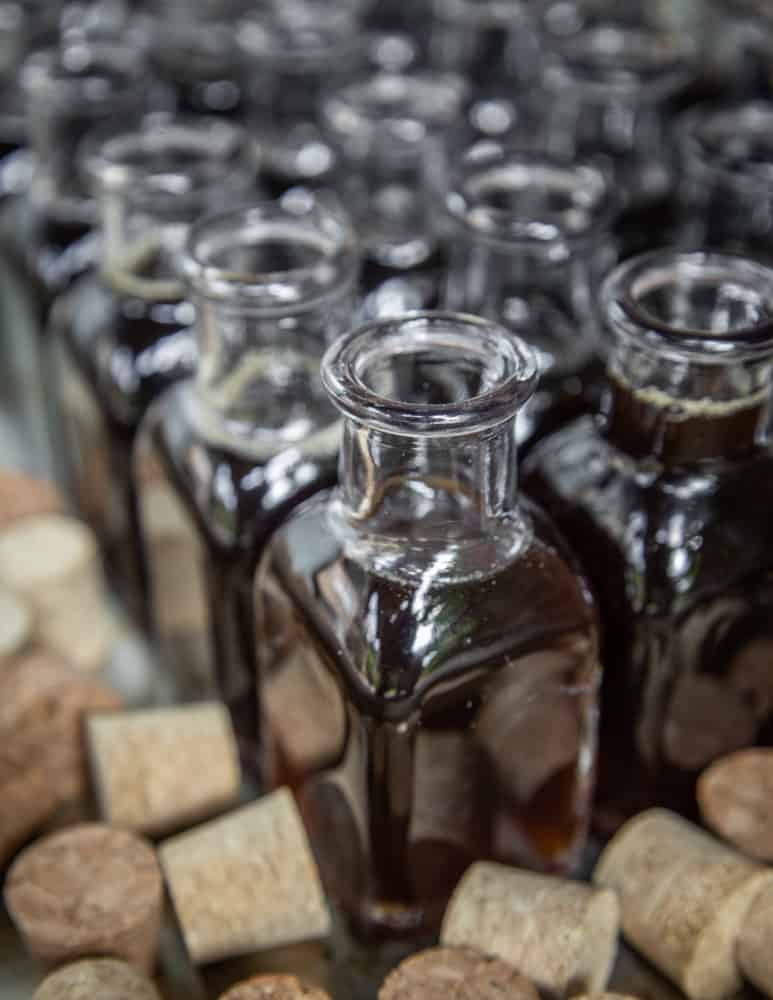
Skimming the foam
Similar to maple syrup, when you cook large quantities of the syrup, it will begin to froth and foam at the top and will double in size quickly.
Some cones seem to create more foam than others, especially Norway Spruce. When you notice foam during the cooking process, do your best to skim it off with a spoon and discard.
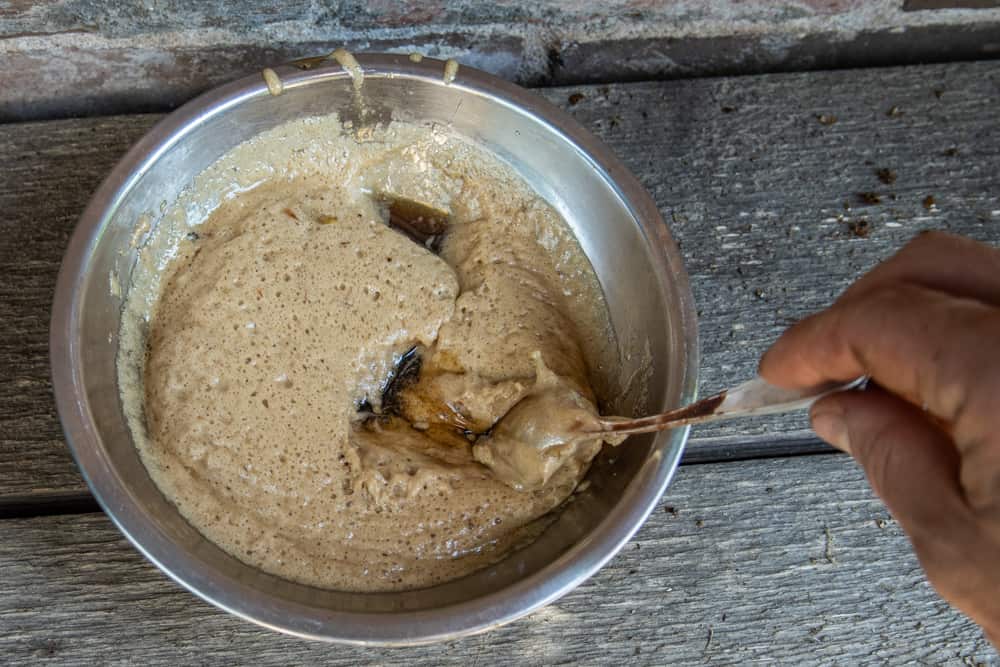
After you bring the syrup to a simmer and strain, put it back in the pot and bring it to a simmer again, let it rest for a minute or two so the syrup can settle and return to it's original volume. If you don't do this, you run the risk of having jars that are half full after settling.
Canning for long-term storage
Pour the piping hot syrup into large jars, or, for smaller ones, pour the syrup into a pitcher with a spout, and pour directly into canning jars (4 oz mason jars make a great gift). Fill the jars nearly to the brim, leaving about ⅛ inch headspace, then, working quickly, screw on the lids tight and turn the jars upside down.
You don't have to water bath-process this as it's basically the same sugar concentration as maple syrup, just make sure your jars are clean. The jars will seal naturally but should be refrigerated after opening.
Here’s a few ideas for using it, and a few things yet on my list to try.
Ideas for using
- Drizzled on pancakes, crepes waffles and other things primed for syrup.
- Use it to flavor whipped cream
- Excellent drizzled over soft cheese like mascarpone, labneh, chevre, etc.
- Drizzled over fresh fruit
- Using in place of honey, I love drizzling it over bowls of warm buttered wild rice with nuts, fruit, and yogurt for breakfast.
- It’s good in desserts, added in small amounts like you would use honey. Dairy based desserts like ice cream, panna cotta and custards of all kinds can just be seasoned to taste with it.
- Try adding small drizzles to salads, or whisking into vinaigrettes.
- Mixing it with a splash of vinegar just to loosen it a bit makes a good brush on or glaze for hams, etc.
- One of my friends adds it to whiskey
Mugolio, or Pine Cone Syrup
Equipment
- 1 quart mason jar or similar
Ingredients
- 2 cups (8 oz) young red pine or other pine cones (soft enough to be cut with a knife) *
- 2 cups (16 oz) organic brown sugar or other brown sugar, just not white which is dry and makes a clear syrup
Instructions
Maceration
- Rinse the cones in warm water to remove any foreign particles if needed. I don't usually wash them. Inspect your cones for any that have holes or insects and discard.
- Combine the sugar and pine cones and pack into a quart jar, then allow to macerate (age) for 30 days. Put the jars in a sunny place where they will get warm during the day, which will help ward off mold.
- During the first few weeks of maceration, open the jar occasionally to release carbon dioxide as the mixture will ferment vigorously. Shake it occasionally to help it on it's journey.
- As the cones release their water, the volume of the contents in the jar will decrease. Sugar slush will settle on the bottom and is natural. If you have more cones and sugar, you can add it to fill up the jar. The less air in the jar, the lower the chance of mold.
Finishing and storing
- After the maceration is complete, scrape the sugar slush and pine cones into a pot and add two tablespoons of water for each quart jar. Bring to a brisk simmer and heat through to melt the sugar, then strain and bottle. Discard the cooked cones and thank them for their service.
- All you need to do is bring the temperature up and melt the sugar, if you reduce the syrup too much it will crystalize after it cools. For the amounts listed it should take about 5-10 minutes.
- The syrup is stable at room temperature since the fermentation lowers the pH, but will keep the best flavor in the fridge. It can also be water bath processed, which I'll do if I sell it. For home storage I pour the very hot syrup into jars, screw on the lids and turn them upside down to seal.

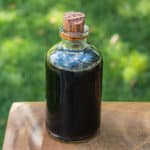
Amy
Just made syrup with lodgepole pine. It's delicious. There was no mold on the cones but there were black spots I washed off the inside of the metal lid. It was not fuzzy, so I'm hoping it's not black mold and is safe.
Alan Bergo
Hi Amy. Black spots on the lid aren’t mold. Remember the syrup is fermented, so the pH is lowered and is acidic. The black spots on the lid are a natural reaction of acid and aluminum. This is why I often use plastic lids for ferments. It’s harmless though, and even if it was black mold it would be destroyed through cooking.
Angela Sinno
I am using small round green cones from my Bold Cypress tree! Are those good for this?
Alan Bergo
I've found that some cypress can be dry. If they don't give off much water you will need to add a couple tablespoons of water per pint jar.
Meri
Good morning Alan,
I am almost certain that my mugolio is brewing, it has bubbles on the wall of the jar ( I had rinsed pine cones and dried before putting them in the jar with sugar) . It has now been more than 20 days since the beginning, for now there are no mold ,lot of sugar is on the bottom not melted. What to do? Do I keep it in a jar for up to a month? With the cooking stop the problem of fermentation? To prevent it from crystallizing, should I put glucose in the pot?
Thanks for the answers
Meri
Alan Bergo
This is natural, and, if you take the time to read this post you'll notice that fermentation is part of the recipe. Follow the recipe as I've described, heating it to a simmer to melt the sugar after 30 days.
Brad
I just finished mine up after 41 days and had the same thing with sugar. It all came awesome. It tastes like nothing I’ve ever had before! I did both a batch of spruce and one of pine.
Alan Bergo
Thanks Brad, glad it worked for you.
Lisa
I am making a few batches since finding your recipie and can‘t pass a conifer without looking for cones.
Recently I found some cones on a branch that fell down in a storm that were so beautiful and wanted to use them for mugolio but could not get all the dirt and sand off, is there a way to do that?
After the cones have fermented for the 30 days or more can one eat the syrup ( or part of it)without cooking it?
And about the other pinecone syrup, was it called Varenje, do you know why you are supposed to cook it, then let it cool, then cook it and let it cool, what does function the cooling off have?
Thankyou for your inspiration
Lisa
Alan Bergo
If the cones are dirty, you can wash them in water.
The syrup is technically edible at any stage. If you want to consume it raw, you'll have to spoon it off the top, avoiding the pine cones, and the un-dissolved sugar in the bottom of the jar. Eating the syrup raw is not traditional, but it won't harm you.
I have a much easier method for making varenye, the repeated boiling is unnecessarily time consuming.
Sookie
Hi Alan
I've been following your recipe (thanks for sharing) and it's now ready for boiling but it has some mould on top and one of the bottles is still fermenting after 8 weeks. Is it still OK to boil up and consume?
Alan Bergo
Hi Sookie thanks for commenting. If you read the recipe, I say to leave the jars for 30 days. 8 weeks is about twice that amount of time and it wouldn't surprise me if you got a little mold on top from leaving it out that long, especially if you haven't been shaking the jar or checking on it here and there. I haven't found that aging the syrup past a 4 week period to have a noticeable enough change in flavor to warrant longer aging.
A few tiny spots of white mold is harmless and destroyed by cooking, the issue here (which I can only speculate on without images) is that if the mold grows unchecked if you forget about it, over time it can ruin the flavor if there's too much of it. The fermentation has nothing to do with if it is ready to cook or not, it'll continue to go for months if you let it. To avoid mold you can make larger batches or just remember to shake the jars regularly to coat them in the fermenting syrup, which lowers the pH and makes the environment inhospitable to bacteria.
Pick the mold off, discard and proceed with the recipe, then let me know how it works for you. I'll be here if you have follow up questions.
Sookie
Hi Alan
Thank you for your good advice. I had kept the cones for double the time as I had added more sugar and cones but now know that it doesn't need that long. I boiled it all up and it tastes great still.
Alan Bergo
Great! Thanks for the update.
Meri
Good morning Alan, I collected and stored the pine cones in the freezer, can I thaw them to make the mugolio ? Thank you . Meri.
Alan Bergo
That will work just fine. I've done it with red pine and spruce tips and cones.
Walter
Hi Alan!
I'm so excited to have found this recipe and the concept in general! In my inner-city neighborhood, a neighbor cut down a perfectly lovely, pine tree, and the front yard was chockablock full of small green pinecones. So I decided to see what I could do with them and discovered your recipes. So I have questions and comments:
Someone rode in and asked about freezing the cones. Will freezing the cones kill the bugs? I read another article somewhere else about putting the cones in the oven to kill the bugs, but that seems counterproductive as it will dry out the cone.
Comment: as I am making my first batch, I burp the mason jar, and turn it upside down. This causes the syrup to drop to the top of the jar. Turning the jar right side up, I skim off a tablespoon of sugar, free syrup, and use it in my sweet tea. Delicious!
Question: regarding cooking the recipe, I am unclear if this needs to be done. This is because syrup is already forming in my mason jar, and although I'm a neophyte at this, I'm assuming that the recipe will be "done" when the sugar has completely dissolved into syrup.
Your time and wisdom is deeply appreciated!
Bon appétit !
Alan Bergo
Hi Walter.
Freezing the cones won't remove the natural yeast, if that's what you're referring to as "bugs". Putting them in the oven will kill them. Turning the jar upside down isn't something I do as it will cause drips and make your jars all sticky. I prefer to shake them to coat the cones with the syrup, both ways can work though.
As far as cooking, I've covered this numerous times now. The syrup is traditionally cooked, and besides honoring the process of a traditional food, The sugar will never completely dissolve unless it's cooked, so yes, it needs to be cooked. If you use honey or maple syrup instead of sugar, they also need to be cooked as the syrup will contain excess water and will be too loose to use as I describe in most recipes. If people are looking for "health benefits" of fermented foods, my advice is to eat a ferment that is traditionally consumed raw, like sauerkraut, or curtido, etc.
Kathy Packard
Hi Alan , are there any pines we should not use for this syrup?
Thank you.
Alan Bergo
Not to my knowledge. Besides the 7 or 8 I've done myself, and having served it in my restaurants for years to thousands of people, I would wager I've tasted syrups of over 15 species people have sent me and all of them have been great, and so different. I might be a little wary of consuming lots of loblolly syrup, but even that one people have been making and I've received positive reports on the flavor. Cedar syrup probably shouldn't be served to pregnant women, but that's out of an overabundance of caution, and I follow the same protocol with carrot seeds-I can eat plenty of both of those and it's one of my favorites to share with people. If there's any problematic compounds they've been exposed both to lacto-fermentation and heat, which is a good first line of defense.
Also, most articles on tree toxicity are probably referring to plants in their raw form, since people don't usually cook pine cones. In this recipe the plant matter is discarded too-only whatever solutes transfer to the syrup are what you consume. To date, I haven't received a report of any batch causing digestive upset or problems of any kind, in any shape or form. The only thing that really seems to vary is the flavor, as some cones will taste better than others, and every single species tastes a little different. Even if there were dangerous cones, the amount used in cooking so small it would be unlikely you'd notice anything. It is far less complicated than something like cassava or working with cyanogenic glycosides like amygdalin.
What kind of pines are you trying to use?
Cindy Ribet
Why would you be wary of Loblolly? I think most of mine is that. I have 50 5oz bottles sealed and labeled and that is just the beginning. But now my husband doesn’t want me selling it in my Etsy store. He is afraid someone will sue us out of house and home. I wanted to do the farmers market but they require a kitchen inspection to get a license or something. Mine would not pass do to a small pet.
I had so much fun and learned so much. Sort of bummed now.
Got any suggestions?
I mean, I win blue ribbons in my state fair for jellies and relish. I’m going to enter a jar of this syrup…..oh, the Hemlock cone syrup is really good. They require it to be sealed in a water bath. Will that over cook the syrup.?
Alan Bergo
Because I haven't made it and there's some warnings about it. That said, there's warnings about Thuja species and I like the syrup I make from those cones. It is most likely fine to use and sell, but I have to be careful with what I recommend here. If it was me, I would serve it to my family and friends after I've consumed a jar through normal use with servings along the line of maple syrup. Then consider selling it. It is fine to waterbath can the syrup.
Stephanie Amundson
Also, is it possible to use honey instead of sugar?
Alan Bergo
Yes of course, and it's lovely. I go over this in my post on spruce tip syrup, where it can be useful as spruce tips contain less water than pine cones.
Stephanie Amundson
How about Lodgepole pinecones from the Sierra Nevadas and their young needle clusters?
Alan Bergo
Pine cones yes. I haven't used young needle clusters, (and I may be mis-understanding exactly what part you're using there) but the tender meristems that grow at the terminal end of the branch work.
Misti
NO: cedar or yew.
Yes/Safe: pine – such as white,black, red pine or pitch pine
Fir – such as Fraser, Douglas, or balsam fir, spruce ok
I do not boil. I add equal parts sugar and cones, burp jar 2 times a day. After burping, shake so all sugar has a better chance to turn into syrup. Some people will drain it after 4-6 weeks And boil it on low. I don't because that you lose the probiotic And many other health benefits.
Brianna
When you say cedar, are you referring to the false cedars in the Cypress family, or true cedars in pinaceae??
Alan Bergo
Common names can be so
funconfusing. I've used Thuja occidentalis, and Cupressus arizonicaBrianna
They sure are! Okay I'm trying this with cedrus deodara green female cones. I've seen a few people make syrups out of it. I hope it will be okay!
Alan Bergo
Let me know how it turns out for you. I've never made a batch I didn't like.
Samantha
This is the most incredible thing I've ever put in my mouth! Easy to make, your directions are very clear. I can't believe people aren't selling this! Really appreciate you sharing and all of the work you've done. I want to make it with every pine cone.
Misti
Hi. I make mine out of Japanese black pine Cones.
NO: cedar or yew.
Yes/Safe: pine – such as white,black, red pine or pitch pine
Fir – such as Fraser, Douglas, or balsam fir, spruce ok
I do not boil. I add equal parts sugar and cones, burp jar 2 times a day. After burping, shake so all sugar has a better chance to turn into syrup. Some people will drain it after 4-6 weeks And boil it on low. I don't because that you lose the probiotic And many other health benefits.I am going to sell 32 oz jars in 4-6 weeks. All organic. $40 each which is a steal when comparing prices out there!
Alan Bergo
If you don't boil it the sugar isn't dissolved. If you want "probiotic effects" eat sauerkraut. This is traditionally cooked. Yes is poisonous and pointless to even consider as it doesn't have cones. Cedar I make and enjoy and have never had a problem serving it to the general public.
Michael Olenick
Have started a batch, (4 quart Mason jars) using Red Cone Spruce, Picea abies 'Acrocona', from our yard. The cones were young and green and easily cut into pieces with scissors. We mixed them with equal parts of dark brown sugar and packed into the jars and screwed the lids on. Within a day or so they had produced enough liquid to fill and cover the cones. I have them in a warm garden window that gets dappled sunlight. It has been 11 days since they were started but I don't see signs of fermentation. When I open the jars every few days there is a slight release of pressure but no signs of what I might consider 'fermentation'. Is this normal? I don't see signs of mold and the smell is pleasantly resinous.
Alan Bergo
The pressure you feel means it's fermenting-that's carbon dioxide. Look closely at the jars and you'll see small bubbles.
Michael Olenick
Thanks. Very small bubbles. When I do release the pressure I can see some bubbles coming up thru the cones. I guess I was expecting a more active fermentation. As long as what is happening is normal then I am happy.
Alan Bergo
Yep. Totally normal.
Michael Olenick
After about 10 days or so one of the quarts started to ferment vigorously while the other three were no so active. I drained about 1/3 of the liquid from all 4 quarts, mixed them together and topped off all the quarts again. This morning I have a very active fermentation in all of them. Curious.They were all made from the same time from the same batch of cones and sugars. Whatever, but they are all fermenting now.
Would you wait until the fermentation stops or slows down before you processed them or would you count a month from the time the fermentation started.
Thank you
Alan Bergo
Hi Michael. You start the timer when the cones go into the jar. That said, if you want to let some jars go longer to taste test, go for it! Just keep an eye on them and give the jars a shake or stir once in a while to release carbon dioxide and coat the cones with syrup.
Chris S.
Thank you for the recipe. I live in Colorado. I have a quart batch of mixed cones (hopefully that’s ok) started, and a quart of spruce tips. I wanted to see the difference. The cones are definitely more satisfying to work with and watch. This is my first time so it’s an experiment. Next year I plan to make multiple batches of specific cones rather than mixed. This batch is Douglas Fir, Scots pine, and blue spruce. The ability to follow the young cones up in altitude should make next year epic, as long as this year isn’t a disaster. Wish me luck and thanks again.
Chris S.
Alan Bergo
Thanks Chris. Yes keeping the cones separate makes it so you can compare and find the exact flavors you like. I do mix them sometimes, but it's more special when people get to taste just how different each variety can be. And yeah, the spruce syrup is great too, but the cones have more water so they're definitely more fun.
Stacy
Hey there! The bottom of the jar is completely saturated. The top half is dry. I turned the jar upside down. Is this okay? Just thought I’d let gravity help it.
Thank you in advance for your reply!
Alan Bergo
As I mentioned, the cones need to be able to be coated with syrup if you press them down or stir them. If they can’t, you should add a little water. Fine to turn the jars upside down, but put the jars in another container to catch any drips.
Stacy
Hello. It’s been almost 2 days, the amount of brown sugar has down about 4 1/2 inches. All of the cones are covered. The brown sugar stuck to my spoon when I stirred it.
If it needs more water come tomorrow, I will definitely add. It already smells divine!
Alan Bergo
Then it's working just fine.
Stacy
Hello. This is the last question I have (I promise).
I went ahead and added some water, and shook very well.
The cones which are pretty big, are not fully submerged. Should I add even more water, or is this okay? Just the top part of the cones are above the liquid.
My apologies for being a PITA!
Alan Bergo
You’ll be fine. No more water. Stir it once in a while to coat the cones with syrup.
Curious GenX
I have just started my first two batches about a month ago. When I burp them they smell like it's a high alcohol content from fermentation. I'm guessing this is normal and will cook off at the end of the process? Is that what the foam is that has to be scraped off?
Alan Bergo
It's likely, and yes this is why it's cooked.
Stacy
Hey there. I live in Northern Arizona and I collected a BUNCH of young pines. (I’m not too sure the type) But I have read that certain cones are too dry (especially AZ). I don’t have any comparison, but they seem very dry!
Should I wait a week to add water, or do it now?
I haven’t ever tried this, and I am excited!!!
Alan Bergo
Hi Stacy. So, I forage in AZ too, my dad just built a house near Gold Canyon so I'm there every Spring. I've harvested the cones of AZ cypress, and yes, most I see down there are extra dry, and seem drought-adapted. You will want to add a little water, a tablespoon or so at a time for a quart jar, until the cones are just barely able to be covered by the sugar slush.
Stacy
Hello again. I don’t know if I will need to add any water as of yet?
There is already quite a bit of sludge 36 hours late. Could it possibly be due to the heat, low 90s in Snowflake?
I shook it this morning, and clumps of brown sugar moved around.
Here’s the question now. If there isn’t enough “water” by what day should I add it???
I’m so excited for this, I definitely do not want to mess it up!!!
Thank you
Alan Bergo
Oh no worries, you won't mess it up. If the sugar looks sludgy after 36 hours you should be fine. After a week, if the cones are not at all able to be covered by the syrup when you shake the jar, add a spoonful of water.
Stacy
Okay, will do!!
Thank you so very much!
Matthew Mengerink
Does anyone know the safety of Deodar cedar and Coastal redwood?
Alan Bergo
I make it with Thuja occidentalis and it works just fine. I would run the fermentation on them and see if you like it.
Matthew Mengerink
Thank you, I just finished the process on the redwood. It is nice, but very acrid and a bit astringent,... but somehow still nice. The Deodar is floral and light (but just 2 weeks in so far). A friend noted that there was concerns about toxicity about both from his research, so I didn't know if you'd spent any time w/ either of these species. THANKS!
Alan Bergo
I mentioned the Thuja cones as they have similar warnings about toxicity. You use such a small amount and the cones aren't consumed I think that's at least part of what negates a lot of warnings you'll see.
Svetlana
Hi Alan,
I noticed that after about 15 days, all the sugar is on the bottom and the cones released their syrup. The flavor is mild. They look done. What changes happen after, and is it really necessary to wait for a month or two? will the flavor change significantly?
Thanks! I am currently macerating Norway Spruce, Ledgepole Pine, Red Pine, and Eastern White Pine. Also I had Mugo pine which I cooked after about 15 days.
Sincerely,
Svetlana
Alan Bergo
Hi Svetlana. Trust me here. I’ve abbreviated this recipe to give a balance of flavor with just about the least amount of macerating time possible. Some traditionalists would probably say 30 days is too little. Have some patience and you’ll get a stronger flavor from those extra two weeks. I know it can be hard to wait.
Svetlana
Ok great! I’m only asking cause my dad used to make the syrup when I was a kid and he said he waited only until the syrup was there, which I’m guessing was around 15 days or so. Also, what role does the quantity of sugar play here? My dad never measured, just filled the jug with cones to the top and poured in as much sugar as fit till the very top.
Thanks for replying to me so quickly!
Svetlana
Thank you for replying so quickly Alan! Not sure if my reply to you went through… so posting again.
What significance does the quantity of sugar play here? Growing up my dad used to make the syrup by filling up the jar to the top with cones then pouring sugar into the jar filling spaces and getting all the way to the top. I’m assuming it was much less sugar than you state in the recipe. Also, we had the syrup as soon as the cones released it, I’m also assuming 15 days or so, because he said he didn’t wait a long time for it. I remember it having a more pronounced flavor.
Thanks again!
Svetlana
Alan Bergo
The proportions here are designed to be the most easily replicable method anyone can use for a variety of cones of different shapes and sizes. If I don’t have exact proportions people will have inconsistent results and potentially hazardous failures.
Svetlana
Yes I totally understand. My question is regarding the double the weight of sugar per weight of pine cones. What would be the difference in flavor/outcome if I were to use 1:1?
Alan Bergo
The pine cones won’t be covered with fermenting syrup and they will mold.
Amy
I have 4 jars going and two have some white mold (I think it’s mold) on the top. Are they spoiled or can I safely scrape it off before boiling?
Alan Bergo
If your cones are large and stick out of the syrup, or it's not shaken or stirred regularly it's possible that could happen. White mold is harmless and killed by heat, the only issue is that if you were to forget about it and the mold is exposed to the syrup for an extended period of time it could affect the flavor. I would scrape the mold off, wipe the rims and inside of the jar with vinegar if you want to keep it going, or just proceed to cooking if it's been longer than 2 weeks.
John Stenglein
Super curious if it's possible to infuse berries such as blueberries in with the syrup? I have some infused with wintergreen that smell amazing. I'm also curious if you infuse any of your syrups with anything else?
Alan Bergo
I’ve added sweetfern, bog myrtle leaves and mints. All were good. Personally I prefer the pure flavor of the species, but you can make all kinds of combinations using your favorite aromatics. If you add blueberries or another juicy fruit expect the water content to be increased by a weight comparable to the weight of the fruit, so you may need to simmer it longer at the end.
Ben
Hi Alan,
I'm testing different cones from our local botanical garden. You mention that you made syrup from thuja occidentalis. I think you know what you after doing, but to my knowledge thuja is a really poisonous plant. Or am I missing something?
Alan Bergo
Hi Ben. I'm definitely pro-science, but sometimes if a plant is poisonous or not simply isn't a yes or no answer and needs some unpacking. For example, studies may not be taking into account if something is cooked or not, and the threshold needed to cause a certain effect could be more than anyone would ever eat. The idea that chickweed is poisonous came from scientific studies of livestock eating multiple pounds of raw plants. The cones aren't consumed here, they're only infused and dosage is often pretty important with things like this, meaning, If you don't want a medicinal effect, don't take a medicinal amount. What that amount is I wouldn't know, but I know it's not near the amount you would ingest using the finished product like maple syrup. I also eat the green cones unripe and have a recipe in my book that uses them as you would juniper. Similarly, cedar tea is probably poisonous in large enough amounts to pregnant women, yet my friend Sean Sherman serves cedar tea in his restaurant. Juniper and cinnamon can be toxic if served in large enough amounts too.
Ben
Great, thanks for your detailed answer Alan! The thing with the dosage makes sense.. If you use Thuja and didn't have any negative effects, it certainly eases my concerns.
Alan Bergo
You're welcome.
Maria
Hello Alan,
I love all your recipes! I am hoping to try this with white pine cones, is this one you've tried too?
Also I recently made a stuffed grape leaf batch with milkweed flowers in the stuffing and I have to say it's a great combo since they are both ready here in Guelph, ON.
All the best to you!
Alan Bergo
Hi Maria, yes I've made this with white pine. Works just fine.
Cindy Ribet
Another question...although I filtered it twice, the second time through a metal coffee filter, my finished bottles have a dark sediment floating on top. Very, very fine. Not a lot. Just enough to see a thin line at the top. Should I worry?
Alan Bergo
Some cones produce a lot of foam, but I haven’t seen particles or anything like that. If it was cooked very recently I would let it settle for a few days and check on it again.
Cynthia C Ribet
There was no significant amount of foam and this is more like tiny particles. It makes a dark thin ring around the surface edge. I think it might be where I have agitated the cones too much stirring every day and it broke pieces off... maybe. I can touch it with my finger and taste it. It has the bitter cone taste. I am filtering again but I think other than the way it looks it isn't an issue. I went over board thinking I would sell the stuff (and the whole process is just plain fun). So I would prefer there not to be a dark ring. May I have permission to link your website so people can see your process and recipes?
Thank you for all your prompt replies.
Alan Bergo
There can be some variation but, again, I haven't had that happen personally. Totally fine (and appreciated) if you link to this post for credit.
Cynthia C Ribet
Here I am again. I have a LOT of this stuff. But all of my bottles have that dark residue at the top. I can't pour it off because as soon as I tip the bottle it follows the surface to the other end of the bottle and does not come out. However, there is still some that sticks to the glass at the top. It tastes yucky. The syrup tastes fine but the residue is bitter. I even tried to take a Qtip and get it out. It helped some. It has the feel on my tongue like very fine dust. I must have just had too much fun stirring it over its fermentation period.
I mean... I even filtered it three times.
And you have never heard of this?
Alan Bergo
Hi Cynthia. As I explain in the post, you should expect variation in flavor between cones. It is impossible for me to speak to every cones people will use. I haven't had of any bitter tasting residue in any of my syrups.
Amy Washburn
Hi! I've had a batch of red pinecone syrup going for about 10 days - it looks like only half my sugar has dissolved...should I add a little water? Thanks!!
Alan Bergo
Some of it will never dissolve during the process. As long as there's enough syrup to coat the cones with liquid if you stir or shake the jar you'll be ok, but you can add a splash of water if you want.
Jill Kurek
Hello Alan. I have reached the 30 day mark and the fermentation continues! Let it keep going? Some of my jars seem darker and thicker than others. Unsure if those would be too "potent " or if dilution is OK? Thank you!
Alan Bergo
I haven't noticed much additional flavor from aging longer. If it's your first time go ahead and proceed with the recipe. Let me know what you think.
Chris Rice
Hi Alan!
I made a small amount of Red Pine Mugulio syrup. I did get a little mold on top so I scraped it off before I low boiled it. Is it still ok? I also made a larger batch of Balsam syrup. I chopped up the cones thinking it would ferment faster. I let it sit, stirring it occasionally, for 30 days. It sure foamed up when stirred and the pine cones floated. No mold or anything. It smells a little like wine. (I did add some water to it when I first started it, maybe I shouldn’t have. ) My Balsam syrup is on the thin side. I cooked it to a temperature of 200 degrees thinking that was syrup consistency. Should I empty all of my sealed jars and cook it down more? Thanks, Chris R.
Alan Bergo
Hey Chris. The smaller the amount of syrup you make, the easier it is for it to mold. Make sure to stir or shake the jars occasionally to coat the cones with the syrup. A little white mold is harmless-pick it off and go for it. The only real issue would be if you forgot about the jar for months and there was lots of white mold, which would eventually affect the flavor. Hope that helps.
Alice
You have been kind enough to answer some of my questions about mugolio, and now I have another one. Can it be made with huge green cones from a deodora cedar? I stumbled upon some beautiful cones but they are about as big as my fist. I have tried to copy and paste a picture, but seems like you are unable to do so in the comments field. Thank you!
Alan Bergo
Yes. Cut the cones into pieces, I would dice them into 1 inch cubes.
Claudia
Hello Alan,
This is my first attempt at mugolio. So far so good. Cooked up my first batch a few weeks ago and have been storing it in the fridge. Any thoughts on why it is crystalizing.
Alan Bergo
That means you cooked it too long, or the cones didn't have a lot of natural water. Typically the former. Add a splash of water, gently warm it or microwave just melt the crystals. Cool. Repeat as necessary until you like the consistency.
Alice Stockdale
Hi Alan,
You have been kind enough to answer some of my questions about mugolio but now I have another one. Can it be made with huge green cones from a deodora cedar? I stumbled upon some beautiful cones but they are about as big as my fist. I’m not having any luck attaching pictures. Sorry!
cynthia ribet
I have turned into the Mugolio monster. I have gallon jars of the starters covering a few tables. I LOVE picking cones. I have Loblolly cones, Shortleaf, Hemlock, and now I have found Atlas Cedar... but don't know if I can use them. Do you? They are huge but very resinous. So if they are safe they should work. I live in eastern NC but want to travel north to keep picking when they run out here.
Alan Bergo
I’ve used similar cedars. What I found with them is that the cones didn’t contain as much natural water even in their green stage so I needed to add a little extra water and sugar, equal parts by volume.
Cynthia C Ribet
And REALLY hard to cut. Maybe I got them too late. I love your site. Learning a lot.
Alan Bergo
Yes the knife should slide through then like you’re cutting a very firm apple. Might be too late.
Jordan
How long would you water bath can for? Little over 1000ft elevation here, typically for a 250ml mason ive done 5-10 min
Shelf stable for a year do you think?
Thanks so much, made pine syrup before but this recipe looks even better. Looking forward to trying different cones as I've always stuck to white pine in past.
Alan Bergo
Honestly I just pour it hot into jars as is done with maple syrup, never had a problem. But, if I were to water bath process I would treat jars the same as you would common pickles for your particular elevation.
John R
I want to try this.
I have a bald cypress tree in my front yard and has a bumper crop of pods on it this year. I can also find the juniper berries locally. Pines I would actually have to go scout. So mainly the cypress nuts
Alan Bergo
I’ve found the cypress to be dry and contained about half the natural water, at least with the AZ cypress-Cupressus arizonica I made this with. If, after a week of macerating the cones are not covered completely with syrup, add a mixture of equal parts by volume sugar and water 1 cup: 1 cup until they’re covered. The flavor of mine was excellent.
Diana Corcoran
I live in the Pacific Northwest, western Washington to be exact. What is your take on using Douglas Fir? I'm excited to try this. Thank you!
Alan Bergo
Yes others have used them.